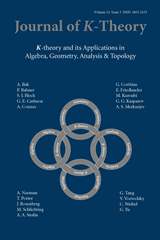Crossref Citations
This article has been cited by the following publications. This list is generated based on data provided by Crossref.
Liu, Dongwen
2014.
Katoʼs residue homomorphisms and reciprocity laws on arithmetic surfaces.
Advances in Mathematics,
Vol. 251,
Issue. ,
p.
1.
Flórez, Jorge
2020.
Explicit reciprocity laws for higher local fields.
Journal of Number Theory,
Vol. 213,
Issue. ,
p.
400.
IKEDA, Kazim İlhan
and
SERBEST, Erol
2021.
Local abelian Kato-Parshin reciprocity law: A survey.
Hacettepe Journal of Mathematics and Statistics,
Vol. 50,
Issue. 5,
p.
1225.

